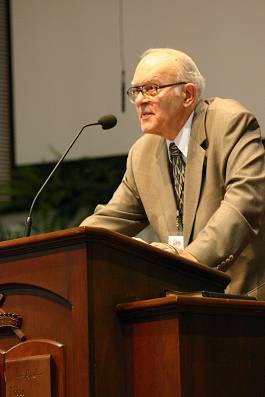 The best books are not always either currently on store shelves or even currently in print. I was reminded of that fact today when I read James Leo Garrett, Jr.’s little book, Evangelism for Discipliship. Published almost fifty years ago, the addresses that comprise this book were originally delivered to the Kentucky Baptist Evangelistic Conference meeting January 15-17, 1962, and published in 1964. I found a copy through an online used book site. I note that one more copy is available from www.abebooks.com.
The best books are not always either currently on store shelves or even currently in print. I was reminded of that fact today when I read James Leo Garrett, Jr.’s little book, Evangelism for Discipliship. Published almost fifty years ago, the addresses that comprise this book were originally delivered to the Kentucky Baptist Evangelistic Conference meeting January 15-17, 1962, and published in 1964. I found a copy through an online used book site. I note that one more copy is available from www.abebooks.com.
My interest in acquiring this book was two-fold. First of all, the subject matter: I am interested in the idea that true evangelism aims for discipleship and not merely conversion. Second, a personal reason: I have the utmost respect for Dr. Garrett, who I took for Systematic Theology at Southwestern Seminary, and who I am privileged to call a friend today. Dr. Garrett has been called the last of the gentlemen theologians. This may well be the case. His impact on Southern Baptist life and education has been significant, and I am part of a large group of former students who realize the great treasure we had in sitting under the teaching of Dr. Garrett. Furthermore, I interviewed him and reviewed his book, Baptist Theology, for The Founder’s Journal here, and earlier for my site here. I have reviewed another work by Dr. Garrett here. I turn frequently to his Systematic Theology and have taught portions of it at Central Baptist Church. What is more, Dr. Garrett wrote the Foreword for my first book, Walking Together, and cast his shadow over my second book, On Earth as it is In Heaven, as well (through his work on church discipline and regenerate church membership).
In this book, Evangelism for Discipleship, Dr. Garrett offers careful definitions of six biblical concepts: repentance, forgiveness and reconciliation, new life, discipleship, and sanctification. His handling is vintage Leo Garrett and offers an early glimpse of the kind of careful, methodical approach that would later characterize his magnum opus two-volume Systematic Theology. By that I mean he offers a thorough etymology of each word and concept, examples of how the concepts have been approached and understood throughout the church universal, examples of fallacious approaches that should be avoided, and concluding comments pointing forward to a healthy embrace of these important truths. In particular, one can note Garrett’s careful ecumenism, his concern for Southern Baptist life, and his impressive grasp of Christian history in this treatment.
The work is, of course, dated at points, particularly when he addresses this or that current issue facing Southern Baptists. A couple of times he approaches the need for racial justice, an idea that was certainly more controversial in the Southern Baptist Convention of 1964 than of today. In discussing regeneration, he interestingly notes that Southern Baptists had perhaps inordinately stressed the human aspect of the new life to the neglect of the sovereign work of God and should be reminded that God is indeed at work in salvation. I could not help but wonder if Dr Garrett could say such a thing now with the advent of neo-Calvinism in the SBC and whether or not he would perceive that particular pendulum as having swung to the other extreme in our day.
Many aspects of this work were quite helpful. In discussing the relationship between justification and sanctification, Dr. Garrett stresses that while the former term is almost always used in Scripture to refer to a moment, the simplistic assertion that sanctification always refers to a process is a bit naive as the New Testament uses the word in other ways as well. Thus, sanctification has a more fluid definition. Furthermore, in discussing the ordo salutis of faith and regeneration, Dr. Garrett proposes not listing these in a chronological sequence on a linear timeline but rather as an upper and lower story singular notion, with regeneration being the work of God above and faith being the response of man below.
I suppose what I found most interesting about this work was the personal and, at times, conversational tone of the work. This is no doubt due to two factors: the fact that these were originally sermons at an evangelism conference and the fact that Dr. Garrett would have been only thirty-seven years old when he delivered them. His age at the time is impressive in and of itself, given the care and scholarly acumen evidenced in this book. Regardless, it was fascinating to hear Dr. Garrett (1) use sermonic illustrations, (2) make direct appeals to the audience concerning current issues in the SBC, (3) evidence some rhetorical flourish at points, and (4) even use humor at one point.
Dr. Garrett is not a humorless or dour man, but he is a historical and systematic theologian. Thus, the work he has primarily done does not lend itself much to these kinds of personal touches. I thoroughly enjoyed reading them!
Is this book still relevant? To be sure it is. A new generation of ministers and laypeople could really benefit from the kind of careful and meticulous approach Dr. Garrett takes here and elsewhere. I suspect that is why I, and others, do try as we can to keep his legacy alive.
If you’re near a theological library or care to search online, this would be a helpful work for you to read and, if possible, own.
